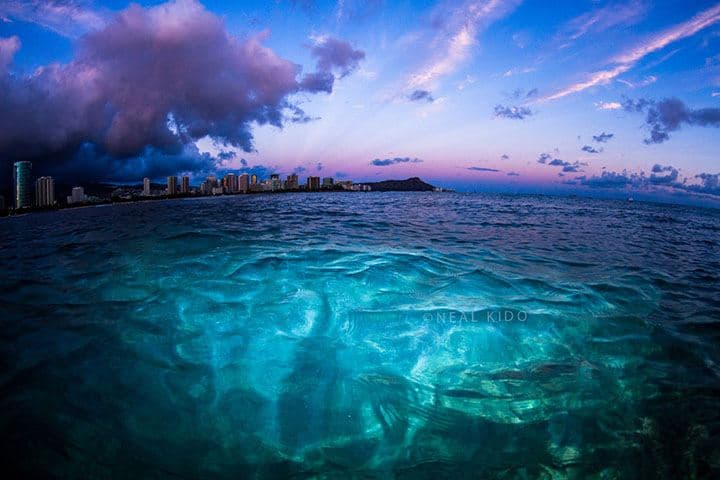By Hawaii.com Team
With six major islands in Hawaii to explore, you’ll enjoy learning the unique characteristics and personalities of each one to determine which destination you wish to experience. Each Island of Aloha offers distinct travel adventures, and discovering which slice of Paradise is ideal for you is all part of the fun!
The northernmost island in Hawaii is also the oldest. Kauai, with its breathtaking beauty and natural landscape, is the ideal location for romance and adventure. From a Na Pali Coast boat cruise that boasts magnificent views of the cliffs, to Waimea Canyon, “The Grand Canyon of the Pacific,” to beautiful sandy beaches, Kauai is the perfect getaway for lovers and outdoor enthusiasts alike.

Waikiki, Oahu. Photo: www.saltyglass.com.
The most populated island in the Island Chain, Oahu is home to the state capitol and an eclectic fusion of natural beauty and contemporary vibe. With modern amenities, flashy nightlife, and a plethora of entertainment, it has something for everyone. History buffs will enjoy the museums and memorials of Pearl Harbor. Sports aficionados can chill on the beach and watch pro surfers take on the death defying waves of the North Shore. Whether you’re soaking up the sun with a cocktail, or learning to surf, there’s never a dull moment on this colorful island.
If stepping into the past and experiencing the culture of traditional Hawaii is on your bucket list, Molokai is an ideal island choice. Half of the population of Molokai is of Hawaiian ancestry, and they are proud to maintain and preserve this historical connection. Visit the quaint town of Kaunakakai and take time to smell the fragrant, tropical flowers of Halawa Valley. Molokai is relaxation at its finest.
If privacy is a priority, the island of Lanai may be exactly what you’re looking for. Luxurious, romantic, and isolated, it’s the perfect island getaway. Tired of sitting in big city traffic? Lanai has not a single traffic light. So if you really want to get away from it all, check out Lanai’s pampering resorts or camp among the beautiful pine trees.
Often noted for having some of the best beaches in the world, Maui is a popular island destination for many Hawaii travelers. Maui is the second largest island and is one of the best places in the world to go whale watching. Maui boasts beautiful scenic drives, and lovely sunrises and sunsets. If you like strolling through town and people watching, the historic town of Lahaina offers lovely restaurants and quaint shops.
If variety is what you’re after, look no further than Hawaii Island, better known as the Big Island. The largest and youngest of all the islands, The Big Island, holds 11 of the world’s 13 climate zones. From the snowcapped peaks of Mauna Kea, to the warm sandy beaches of the Kohala Coast, it truly is a world all its own. Explore waterfalls and rain forests, or discover one of the most active volcanoes in the world at Hawaii Volcanoes National Park. You won’t be disappointed!
Can’t decide which island to visit? Consider booking a vacation package that includes island hopping.
There are actually over 100 different islands in the Hawaiian Archipelago. The six islands described above, Kauai, Oahu, Molokai, Lanai, Maui and Hawaii Island, are known as the six major Hawaiian Islands because of their size, population and accessibility. There is also the 11 mile long island of Kahoolawe which sits just off shore from Maui and Lanai and is uninhabited. In 1993 it became a reserve, restricting all commercial use. The island of Niihau which is smaller than and sits to the west of Kauai is known as the “Forbidden Island.” Niihau is privately owned. Access is strictly limited though tours are offered. The population of less than 200 speak Hawaiian as their first language. Together, these make up the eight major islands.
So where are the other 100 or so islands? To the west of Niihau. There is a long string of tiny islands and atolls that extend west and north of the eight major islands. They are known as the Northwest Hawaiian Islands. Uninhabited but for research scientists and the like, these islands are home to thriving marine ecosystems. In 2006 they were incorporated into the Papahānaumokuākea Marine National Monument.
All Hawaiian Islands were formed by a hot spot emitting magna through the earth’s crust and sea floor. As the tectonic plate of the earth’s crust shifted slowly over time, the older islands moved to the northwest and began to erode as new islands formed to the southeast. Kilauea volcano on Hawaii’s Big Island is where we see the hot spot activity today.
There is one more island in Hawaii. To the southeast of Hawaii’s Big Island, growing below the ocean’s surface, is the newest Hawaii Island. It’s name is Loihi, meaning “long.” Still technically a seamount rather than an island, Loihi is not expected to surface for at least another 10,000 years.
Remember, because the Hawaiian Islands are close in proximity, visitors and locals alike enjoy island hopping.
Join our newsletter for travel inspiration, insider tips and the latest island stories.
By subscribing, you agree to receive emails from Hawaii.com. You can unsubscribe anytime. See our Privacy Policy.